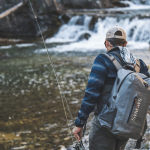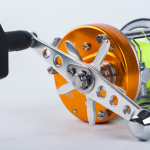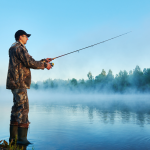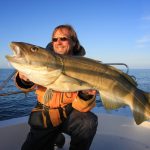Fishing for bass is a fun and rewarding experience for anglers of all levels. Here we’ll talk about How to fishing bass. This guide will give you useful tips and techniques for successful bass fishing. From picking the right gear to knowing where to find bass, let’s explore the basics of bass fishing.
Proper Guideline of How to Fishing Bass
Step 1: Gear and Tackle
Certainly! Let’s provide more explanation for each of these key aspects of bass fishing:

1. Fishing Rods and Reels
Medium-Weight Spinning rod is a good choice for beginners and offers versatility. It’s easier to use than a bait casting rod and can handle a wide range of lures and techniques. Choose a spinning rod that feels comfortable in your hands and matches your skill level.
Bait casting rods are typically preferred by more experienced anglers because they provide greater control and accuracy when casting. They are especially useful for precise lure placement. However, they have a steeper learning curve and may take some practice to master.
2. Fishing Line
Monofilament is a forgiving and all-purpose fishing line suitable for various fishing situations. It’s easy to manage, floats on the water’s surface, and provides good shock absorption. Select a monofilament line that is strong enough to handle the size of bass you intend to catch.
Fluorocarbon is less visible underwater compared to monofilament, making it an excellent choice when bass are wary or in clear water. It has low stretch, so it offers better sensitivity for detecting bites. Again, choose a fluorocarbon line with an appropriate strength rating.
3. Baits and Lures
Plastic worms are one of the most versatile and effective baits for bass. Texas and Carolina rigs are popular setups for plastic worms. The second one is crank bait. Crank baits are designed to mimic the appearance and movement of small fish. They come in various diving depths and can be retrieved at different speeds to imitate injured prey.
Thirdly, Spinner baits have spinning blades that create vibrations and flash in the water, attracting bass. Jigs consist of a lead head and a skirted tail. They are versatile and can be used in a variety of fishing situations, including flipping and pitching into cover.

The best bait or lure can vary based on factors like water conditions, weather, and the mood of the bass. Don’t be afraid to try different options and adjust based on what works best on a given day. Remember that successful bass fishing often involves a degree of trial and error. As you gain experience, you’ll develop a better understanding of which rods, lines, baits, and lures work best for your specific fishing location and conditions.
Step 2: Understand bass behavior
Let’s break down these points in simpler terms:
1. Habitat
Bass like to hang out near things underwater that can provide cover and a good place to hide. These things can be rocks, fallen trees, plants, or areas where the bottom of the water gets deeper (underwater ledges). They hide there because it makes it easier for them to surprise their prey and catch it.
2. Feeding Patterns
Bass are most active and hungry during the early morning and late evening, around the time when the sun is rising and setting. So, if you want to catch bass, it’s a good idea to go fishing during these times because that’s when they are looking for food.
3. Seasonal Changes
Bass behave differently depending on the time of year. In the hot summer months, they tend to move to deeper parts of the water because it’s cooler there. In the spring and fall, they come back to shallower areas because the weather is milder. So, if you’re fishing in the summer, look in deeper spots, and in the spring and fall, focus on shallower places. Adjust your fishing techniques based on where you think the bass are hiding.
Understanding these things about bass behavior can help you figure out where, when, and how to catch bass for them, which increases your chances of catching them.
Step 3: Fishing techniques
Learn these fishing techniques of how to fishing bass correctly:

1. Casting and Retrieving
This is like throwing your bait or lure out into the water near things where bass might be hiding, like rocks or trees. Then, you slowly turn the reel handle to bring the bait back in. Imagine your bait is a wounded fish, so move it slowly like its struggling. Every now and then, make it twitch or jerk a little to make it look more interesting to the bass.
2. Pitching and Flipping
When there are a lot of things in the water that could tangle your line, like plants or branches, you use pitching and flipping. It’s like dropping your bait straight down into those tangle-prone spots. You don’t cast it far. Be ready because when a bass bites, it can happen quickly.
3. Top water Fishing
Sometimes, bass like to come up to the surface of the water to catch their prey. In these situations, you use special lures that stay on the water’s surface. They might look like insects or small animals. Cast these lures out during times when there isn’t too much sunlight, like early morning or evening. When a bass strikes, it can be really exciting because you often see the splash.
4. Drop Shot
This is a more delicate method of how to fishing bass. You put your bait on a special rig where it hangs above the bottom of the water. It’s like tempting the bass by suspending your bait in front of them. This works well when you know bass are in deeper parts of the water.
Each of these techniques is like a different tool in your fishing toolbox. Depending on where you’re fishing and what the bass are doing, you can pick the one that’s most likely to get their attention and make them bite.
Step 4: Patience and Release
Successful bass fishing requires patience and a sharp eye. Be ready to set the hook when you feel something unusual. Conservation is crucial in bass fishing. Engage in catch and release to safeguard the bass population for generations to come. Handle fish gently, use barbless hooks when possible, and release them promptly.
Frequently Asked Questions (FAQs)
Where do bass like to hide?
Bass often hide near structures such as rocks, fallen trees, vegetation, and underwater ledges. They prefer these hiding spots to ambush their prey.
How should I handle bass once caught?
Handle bass gently, use wet hands to touch them to protect their slime coat, and consider using barbless hooks for easier removal. Adopt catch and release as a method to preserve the bass population.
What are some signs that a bass is biting?
Look for subtle movements or vibrations on your fishing line, which could indicate a bite. Be ready to set the hook when you feel any unusual tension or tugging.
Do I need a fishing license to catch bass?
Yes, in most places, you’ll need a fishing license to legally catch bass. Regulations can vary by location, so check with your local authorities to ensure you’re in compliance.
Conclusion
Bass fishing is a thrilling hobby that offers endless opportunities for learning and improvement. By choosing the right gear, understanding bass behavior, mastering various techniques, and practicing patience, you can increase your chances of a successful day on the water. Always respect nature and the bass population by practicing ethical fishing and catch and release. Enjoy your journey of how to fishing bass.







